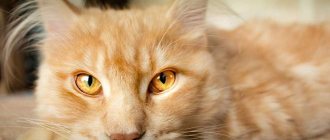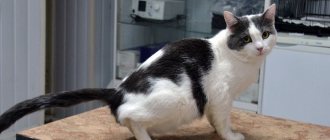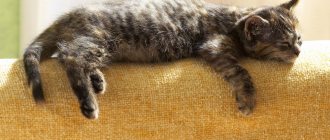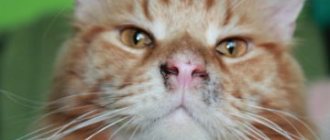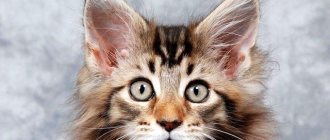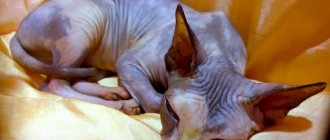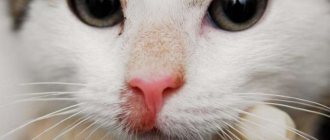Vomiting in cats is a natural defense mechanism of the body that occurs in many situations. This is not a disease, but only a sign of a certain disorder. The process itself is unpleasant and, if repeated regularly, poses a danger to the life of the animal. Experts call one of these “alarm bells” the problem when a cat vomits undigested food after eating.
Causes of vomiting
Vomiting in a cat can be caused by many reasons, both everyday and truly dangerous - in some cases it is a symptom of serious diseases that can significantly harm the cat's condition or even lead to death. Treatment of vomiting must begin with a correct determination of the cause of its manifestation, otherwise the methods used may turn out to be completely ineffective or even worsen the situation.
Household causes of vomiting (quite natural and do not pose a serious threat to the health of the animal):
- in one meal the cat ate a large amount of food for its stomach;
- swallowing large pieces too quickly;
- accumulation of hair in the stomach (regular ridding of the body from hairballs that enter it during licking is a natural process);
- rejection of grass by the stomach (cats instinctively eat some herbs themselves to cleanse the gastrointestinal tract of toxins).
In some cases, vomiting is a symptom of dangerous diseases (they can cause severe harm to the animal’s health or even lead to death):
- malignant tumors (oncology);
- plague;
- acute form of gastrointestinal tract diseases;
- viral infection;
- ketosis;
- acute toxic poisoning;
- worms;
- diabetes.
Another possible reason that a cat burps is the body’s reaction to the treatment of a disease (if medications with strong effects are used that cause a stress reaction in the body).
Treating a cat for vomiting
You should not try to stop vomiting on your own - without knowing the true cause, you can cause serious harm to your pet.
When the owner notices that the cat has vomited after sterilization, he may panic, but there is no reason to worry: the cat has undergone anesthesia and is recovering from it, or she was fed early. No treatment required. A one-time case in a cat after vaccination also does not need help.
In case of poisoning, the cat should be given absorbents; if severe poisons are suspected, a veterinarian will be treated.
In any case, you can help your cat with vomiting with drugs that restore the water-salt balance.
The doctor will prescribe a diet and prescribe pills that will protect the cat’s body from another “stomach evacuation.”
Phosphalugel
The gel has a uniform consistency, has a pleasant taste and is white in color. The contents of the sachet are used according to the dosage: for cats, 0.5 ml is calculated for each kilogram of the pet’s weight.
Mezim
Mezim is classified as a human drug approved for ingestion by animals. For treatment, use a quarter of the tablet, which is turned into powder and treated to the kitty 15 minutes before meals.
Cerucal
Cerucal can be purchased in the form of tablets and injections. The dosage is calculated based on the weight of the animal: 0.2-0.4 mg per kilogram of the animal’s weight. Reception is carried out 3-4 times a day.
Smecta
The substance is in the form of a white powder, available in sachets. For a medium-sized adult cat, 1.5 g of medicine is enough. The powder is diluted to a mushy state with boiled water (50 ml).
global $ads_google; //data-ad-slot=”2475549904″ $ads_google = empty($ads_google) ? false : true; ?> if ($ads_google == false) {?> $ads_google = true; ?> } ?>
You should not leave the process of vomiting in a cat to chance - its owner is responsible for the health of the animal.
Types of vomit
You can determine the cause of vomiting and plan a further plan for its treatment, first of all, by studying the nature of the discharge. Based on the accompanying signs, you can find out what exactly caused the stomach rejection.
Impurities in vomit are of the following types:
- Bile and vomit are yellow. Such discharge is a pathology, because Bile should not be released from the stomach on its own. Such vomiting is most often caused by too long a urge, when the stomach is already completely emptied; other possible causes are diseases of the gallbladder and biliary tract.
- Green impurities. All green discharge is a sign of severe pathology in the body, in particular, intestinal obstruction or inflammation of the bile ducts, because It is the high bile content that gives vomit its characteristic green color.
- Blood impurities. Can be of different saturations. If there is a small amount of blood and the vomit is light red or pink, this indicates minor damage to the mucous membrane of the oral cavity, pharynx or esophagus. If the vomit is a rich or dark red color, then this is caused by severe internal bleeding in the intestines.
- Wool. If hair in vomit is seen in tufts or many individual hairs, while no other impurities are observed, then the owner of the animal has no reason to worry, because by secreting vomit, the cat’s body simply gets rid of the indigestible hair that has entered the stomach.
- Leftover food. If all that is excreted in the vomit is undigested food without additional impurities, then the cause of vomiting is overeating or the animal swallowing large pieces too quickly. There is no need to worry, just reconsider your pet’s diet a little.
- White foamy discharge. Such vomiting is not dangerous if it is one-time in nature. Its reason is that there is an excess of gastric juice in the stomach, which simply has nothing to digest; it collects into white foam and is excreted from the body.
- Slime. Mucous discharge is a symptom characteristic of gastric ulcers or acute forms of gastritis.
- Fecal impurities. The content of excrement in the vomit is a very alarming symptom, indicating possible peritonitis, intestinal obstruction or internal damage to the abdominal cavity.
Owners of furry friends should keep in mind that even if they carefully study the nature of vomit, it is still impossible to draw clear conclusions based only on the presence (or absence) of certain impurities in the vomit.
In order to have a more accurate idea of your cat’s health, you also need to pay attention to the following factors:
- frequency of vomiting;
- the pet’s desire to drink as much water as possible;
- maintaining appetite;
- manifestation of other signs of poisoning (diarrhea, dehydration);
- general well-being of the pet (appearance of lethargy, constant fatigue, lack of interest in what is happening around).
Diagnosis of cat vomiting
People often forget that it is necessary not only to remove the symptom, but to understand the cause of the phenomenon. Vomit can be a symptom of various disorders in the cat's body. To understand the true cause of regurgitation, you need to look at vomiting - after diagnosis, it will become clear whether the animal requires urgent treatment, and what kind of treatment.
The cat is vomiting blood
When an owner notices blood in a cat's vomit, they may begin to panic. Should not be doing that. You need to get together and first of all study the unpleasant phenomenon.
Perhaps there is scarlet blood in the mass, or the mass itself is thick and brown. If the vomit is still brown, then there is a high chance of gastric bleeding. It could be caused by a foreign body, a tumor, an ulcerative process, liver disease, acute gastritis and some other diseases. Why brown? Because it contains not only blood, but also gastric juice.
Scarlet bloody vomit or a distinct pink mass indicates bleeding in the esophagus or mouth. There is nothing that can be done here other than taking the cat to the clinic.
Black vomit
Black vomit in a cat can also frighten owners. Typically, such a scourge does not manifest itself without accompanying symptoms: along with regurgitation, fever, drowsiness, weakness, pain, diarrhea, and signs of dehydration appear. They do not take any independent action - only a specialist treats the problem. The owner's task is not to try to feed the cat, but to get him to the doctor as soon as possible.
Clear vomit in a cat
Both an adult cat and a small kitten can vomit clear liquid. Instead of the contents of the stomach with pieces of food, there is simply clear water with some gastric juice. A small amount of mucus from the esophagus may be present.
global $ads_google; //data-ad-slot=”2475549904″ $ads_google = empty($ads_google) ? false : true; ?> if ($ads_google == false) {?> $ads_google = true; ?> } ?>
The causes of the phenomenon are parasites, dyspepsia, swallowed hair that irritates the walls of the esophagus. But not everything is so simple: such regurgitation can be caused by diseases of the thyroid gland, kidneys and cancerous tumors. In this case, it is worth paying attention to the frequency of the phenomenon and other signs.
Vomiting bile
Simple yellow vomit occurs when a cat's diet consists of industrial food. But if the vomit is a bright, rich yellow color, even orange, it means that bile has spilled into the stomach.
Causes
Bile entering the stomach is caused by problems with the biliary tract or liver disease.
Treatment
It is better to re-learn the nutritional tips for cats: fatty foods are completely excluded, not to mention stale ones. The second step will be to consult a veterinarian to check the animal’s condition.
The cat has green vomit
Green vomit appears when a lot of bile or even intestinal contents have splashed into the stomach. Usually the process is triggered by a severe infection. This requires urgent help from a veterinarian, and not treatment at home, take care of your cat!
When a kitten or cat vomits greens and hair, everything is not so critical: the pet probably tasted green grass, and before that it swallowed its own wool - and this is where the stomach self-cleanses from the fur that has filled it.
The cat is vomiting white foam
It happens that a cat vomits white foam - a one-time occurrence does not pose a threat. Nausea begins when food has been digested and sent to the intestines, and mucus and gastric juice remain in the empty stomach. The air that gets into them helps to form a foamy white mass. This happens at any age: both in old cats and in young ones after giving birth.
Repeated foamy vomiting in cats indicates the presence of chronic stomach diseases. Foam is a derivative of mucus that protects the walls of the organ, and in its absence, ulcers can form.
Foam vomiting is often observed in a kitten after switching to solid food: the stomach is often full, which triggers the gag reflex. The process is quite long and stops only when mucus and gastric juice come out in the form of white foam. In adult animals, such a stomach reaction is also possible when switching to a new type of food.
Veterinary medicine indicates that beginning gastritis is one of the causes of morning white cat vomiting with foam. Parallel symptoms may include alternating diarrhea and constipation, refusal to eat, and apathetic behavior.
If the foamy vomit contains some hairs, the cause of the problem is a hairball stuck in the stomach. The green grass fibers will help the animal get rid of the foreign body.
It is not at all good if, in addition to foam, bile or blood is found in the contents ejected from the stomach: the cat is shaking and is tormented by constant diarrhea, nervous attacks develop: urgently see a veterinarian.
Vomiting mucus
Vomiting in a cat with mucus in it does not bode well: among the causes include erosive and chronic gastritis, intestinal diseases, and viral diseases.
Vomiting in cats after eating
There are several reasons for this: the cat could have eaten to its heart’s content, and the gag reflex was triggered. Or the cat ate too hastily, swallowing pieces - such a meal will not be beneficial. In both cases the phenomenon will be one-time.
global $ads_google; //data-ad-slot=”2475549904″ $ads_google = empty($ads_google) ? false : true; ?> if ($ads_google == false) {?> $ads_google = true; ?> } ?>
Sometimes the owner notices that the pet is constantly vomiting immediately after eating undigested pieces - the veterinarian is already waiting for his patient, because this is a serious sign of inflammation in the gastrointestinal tract. This happens due to pain while eating and the stomach’s refusal to digest food in the usual manner. Why is it worth going to the clinic as soon as possible? There have been cases where a cat has vomited after eating due to intestinal volvulus.
Vomiting in a pregnant cat and small kittens
Just like in humans, pregnant cats' bodies are under stress and have increased sensitivity. That is why toxicosis and morning vomiting are absolutely normal for future furry mothers. They are explained by the fact that for a pregnant cat the entire environment becomes too toxic, and the rejecting reaction of her body is completely conditioned. The stomach of a pregnant cat may reject food due to the fact that the fetus puts strong pressure on the internal organs.
Owners of pregnant cats should definitely pay attention to the appearance of impurities in the vomit - as long as they are absent, there is no reason for alarm, but if blood, bile, mucus, etc. appear. – to preserve the health of the cat and its future offspring, it is necessary to contact a veterinarian as soon as possible!
In small kittens, nausea, as a rule, is not a signal of a serious pathology (except in cases where vomiting occurs very often, and there are dangerous impurities in the masses).
The two most common reasons why a kitten vomits:
- After eating, the cub plays too actively and makes a lot of intense movements, which significantly complicates the digestion process, and, accordingly, not all the food eaten is digested;
- a kitten has a slight pathology from birth - due to the incorrect position of the sphincter, its stomach cannot fully digest all the incoming food, and in order for the stomach to cope and no more vomiting, you just need to reduce the portions for each feeding.
How to feed a cat when vomiting
At the clinic, the specialist will definitely recommend putting the cat on a gentle diet or keeping it on a fast for 1-2 days. Fasting allows the mucous membrane to recover after vomiting. The presence of an inflammatory process in the gastrointestinal tract prevents the complete breakdown and absorption of food, so any food will not only be useless, but will also lead to new attacks.
In case of one-time vomiting not associated with diseases of the digestive tract, feeding the animal after some time is allowed. As a rule, the cat itself lets you know about it. In such cases, the first meals are a diet menu that excludes fatty and protein foods. You can include in your diet: rice water, vegetable puree (for example, intended for children), low-fat broth. If your pet is accustomed to industrial food, then you need to choose special offers from the medicinal category.
Urgent visit to the veterinarian
The information given above divides the causes of vomiting into two conditional categories: dangerous (manifestation of serious diseases) and not dangerous (removal of foreign objects, excess gastric juice, cleansing the body, etc.). If a cat vomits once or recurs with some regularity, the owner needs to determine how serious the symptoms are and, accordingly, decide whether immediate contact with a veterinarian is necessary or not.
You should seek veterinary help as soon as possible if:
- the cat vomits often and in large quantities, even after the stomach is completely emptied, the animal does not stop urge;
- impurities characteristic of dangerous diseases are constantly present in the discharge
- the pet’s general condition is lethargic, he constantly wants to sleep, he loses his appetite and interest in the world around him;
- there are accompanying symptoms of poisoning - diarrhea, fever, fever;
- The pet's condition is rapidly deteriorating.
When going to the veterinarian, it is better to make an appointment by calling in advance so as not to waste time in queues. With certain diseases, hours and even minutes count – the sooner the veterinarian intervenes, the greater the pet’s chances of recovery. You must take with you all the necessary documents of the animal (their availability and quantity depends on the breed and the club to which the cat belongs). It is also recommended to take a sample of vomit with you to make a diagnosis as quickly as possible.
First aid
To improve your pet's condition, you can give him a mint decoction a little at a time.
When a cat vomits foam and other unpleasant symptoms appear, owners should know how to alleviate the condition of their pet. If your pet vomits once and his health is normal after that, then there is no need to sound the alarm. It is recommended to give the cat rest and not feed him for several hours. In this way, it will be possible to relieve the digestive organs and restore their functioning. The next day, if the cat no longer vomits, then it is allowed to give boiled rice based on chicken broth. Meals should be small but frequent. It is useful to make a decoction of mint as first aid when a cat is vomiting foam. If your pet refuses to take it, you can try pouring the medicine into the mouth using a syringe. When the animal does not stop burping foamy saliva, and its condition quickly worsens, it is necessary to immediately take the patient to a veterinary clinic.
First aid for a pet
You can also help your cat at home. If signs of dangerous vomiting are detected, the following measures should be taken immediately:
- Immediately stop the toxic substance from entering the body. Effective if vomiting is caused by poisoning. If the owner does not know exactly what exactly caused the dangerous symptom, the pet should be closely monitored before contacting a doctor and any attempts by the animal to eat anything should be stopped.
- The cat's body must exclude the possibility of dehydration. To do this, you must constantly offer your pet clean water. If he does not feel thirsty and does not drink on his own, he must be given water by force, the main thing is that a sufficient amount of liquid is always present in the weakened body. The exception is the case when water provokes new vomiting.
- If you suspect that the cat has swallowed some foreign object, and it is this that is causing vomiting, you can examine the animal’s throat yourself. If you find a foreign body, but find it difficult to remove it yourself, you should immediately contact a veterinarian - if you risk doing it yourself, you may injure your pet.
Probable Causes
The reasons why a cat vomits after eating may be as follows::
- poor quality diet;
- feed intolerance;
- binge eating;
- deviations in the operation of internal systems.
Incorrectly composed diet
The reason why a cat vomits after eating may be its diet. The animal must receive high-quality protein that provides it with a feeling of full saturation. Otherwise, the pet can simply get rid of low-quality food, cleansing the stomach in the most physiological way: it simply vomits.
To avoid the development of vomiting attacks caused by bad food, you need to be extremely careful when preparing your fluffy’s diet. It is best to buy premium or super-premium food, since they contain all the necessary substances and microelements. And, very importantly, they are made from real meat.
Budget food contains no more than 2–3% natural meat. The remaining mass is represented by by-products that represent virtually no biological value - skin, feathers, veins, heads and beaks.
The animal’s body may refuse to accept such food and respond to it with a gag reflex.
© shutterstock
When purchasing food, you need to study its composition. If it contains preservatives, dyes, propylene glycol and ethoxyquin, then you should avoid purchasing it. It will not give anything useful to the pet.
Feed intolerance
Sometimes a cat vomits after eating undigested food due to its body’s inability to accept certain foods. For example, your pet may be lactose intolerant. And then after consuming whole cow's milk, he also vomits.
Most often, nausea develops when feeding an animal natural food. If the diagnosis confirms this, then it makes sense to transfer the pet to specialized dry food that completely excludes possible allergens and controversial components.
Overeating and eating food too quickly
A cat sometimes vomits from overeating and the reason for this is the special structure of the esophagus. It is located horizontally. With a rapid intake of food or its significant volumes, the animal’s body can block the sphincter that opens the entrance to the stomach. In this case, the cat is forced to get rid of excess food by regurgitating it. As a rule, he vomits some time after eating.
Most often, such vomiting attacks develop in animals if several pets live in the same area . Competition for food forces the murka to eat as much food as possible during one feeding. The problem can be solved simply: it is enough for each cat to have its own bowl or to feed the cats in different rooms.
Deviations in the functioning of internal organs
If a cat vomits after eating food, then the causes may be pathologies of the internal organs. In particular, with inflammation of the pancreas, an insufficient amount of digestive enzymes is produced, which provokes disturbances in the digestion of food. Vomiting becomes a secondary manifestation of pancreatitis: an animal with this pathology vomits after eating quite often. Symptoms of pancreatitis include increased thirst coupled with a lack of appetite.
The cause may be inflammation of the gastric mucosa -
gastritis. The animal vomits after eating and against the background of other pathologies :
- inflammation of the intestinal walls;
- irritable bowel syndrome;
- enteritis;
- colitis;
- malfunction of the endocrine system and others.
To identify the true cause of vomiting, your pet needs to undergo a complete diagnosis of the body. Because attacks can be eliminated after identifying the causes of their occurrence.
Vomiting of ants bearing kittens is worth highlighting as a separate category of problems. If a pregnant cat vomits after eating and occurs long enough, the cause is an enlarged uterus and its pressure on the stomach. To avoid this, you need to feed the expectant mother in small portions. But a veterinarian will help determine more precise reasons why a pregnant woman is vomiting.
Treatment
The main rule for treating a pet when vomiting occurs is the absence of independent diagnosis and the use of unknown drugs. Only a professional veterinarian can determine the cause of vomiting and prescribe treatment; making such decisions independently is negligence towards the pet.
For vomiting caused by various reasons, pets are prescribed one of the following medications:
- antispasmodics;
- gastroprotectors;
- antiemetics.
The choice of treatment method is always selected by the veterinarian for each individual case. For example, in some situations, for recovery it will be enough to keep your pet on a diet for only a few days, in others it is impossible to do without surgical intervention.
To accurately determine the diagnosis at the veterinary clinic, specialists take a number of tests: urine, blood, saliva, feces, etc. Based on their results, it is possible to better determine what caused the vomiting and prescribe effective treatment.
When is vomiting dangerous?
The gag reflex is a protective reaction of the body aimed at cleansing the stomach of foreign objects, poor-quality food, and toxic substances. The process of regurgitation is caused by strong contractions of the abdominal muscles and diaphragm.
Often, vomiting in a pet does not require treatment. Cats swallow their own fur, Christmas tree rain, broom fragments and other foreign bodies. In this case, they soon feel a bout of nausea, followed by a gag reflex. The contents of the stomach are expelled. If the pet feels good after this, plays, eats, drinks, then everything is fine.
An examination is necessary if the cat vomits not only after eating, but also at other times. Veterinarians advise bringing your pet for examination if he has burped 3 or more times. Failure to provide assistance can lead to dehydration, but this is not the worst thing that can happen. Sometimes vomiting is one of the symptoms of infectious diseases, for example, plague (panleukopenia).
Vomiting after eating in cats occurs due to ingested fur.
Pet diet
Having made a diagnosis and carried out the necessary procedures in the clinic, the doctor will definitely give individual recommendations on diet. There are also general principles for feeding your pet when vomiting:
- On the first day, the cat should not eat at all. Any food must be excluded so as not to irritate the weakened intestines. Water should be limited if it provokes new spasms in the cat. To avoid dehydration, it is recommended to let your pet lick an ice cube.
- Further nutrition should not be difficult for the gastrointestinal tract. It is recommended to make a diet from boiled rice, baby puree, soft-boiled eggs, boiled chicken and low-fat cottage cheese.
- Portions should be small and meals should be frequent.
- If you feed your pet dry food, then during the period of exacerbation of the disease it must be replaced with medicinal food.
Vomiting is not always a terrible thing; it is often just a natural reaction of the body and should not cause alarm. However, you need to carefully monitor your pet's health, and if this symptom recurs with some regularity, then it is very important to consult a doctor in a timely manner so that the situation does not worsen.
How to treat and diagnose a cat's vomiting white foam?
The veterinarian will definitely conduct a visual examination and palpation of the cat’s abdominal cavity. Since there are many reasons that provoke vomiting, additional laboratory examinations - blood tests, general and biochemical urine tests. They allow you to assess the condition of internal organs, as well as confirm or exclude feline distemper.
To exclude
panleukopenia and giardiasis, it will be necessary to conduct a microbiological examination of stool.
An abdominal x-ray is used to identify foreign bodies in the gastrointestinal tract, tumors, intestinal obstruction or coprostasis.
Ultrasound allows you to evaluate the structure of the kidneys, intestines, pancreas, intestinal motility and blood flow in the kidneys.
If the veterinarian suspects gastritis , an ulcer or a tumor in the stomach , then gastroscopy . With its help, the mucous membrane of the esophagus and stomach is examined, and a biopsy of the tissues of these organs is performed.
Therapeutic measures if the cat vomits white foam frequently
If your cat has vomited once or twice and remains alert and active, there is no need to worry.
Sometimes cats themselves look for grass to eat it and induce vomiting, thus clearing the stomach of accumulated hair.
In case of a normal stomach upset, the pet
should be stopped feeding, but not limited in drinking.
Short-term fasting for up to 12 hours helps the body cope with disorders on its own.
The next day, the animal is often and little by little fed rice or oatmeal porridge in chicken broth. When the cat does not get better and the vomiting does not stop , but rather intensifies, other symptoms of ill health appear - diarrhea, fever, lethargy, blood in the vomit, etc., put everything aside and seek help from a veterinarian, since self-medication is no longer effective.
The veterinarian can prescribe the following medications and therapeutic measures for your cat:
- if the animal does not eat and the vomiting does not stop, the doctor will prescribe drips with solutions of electrolytes and glucose, which will restore the level of fluid and important elements in the body;
- a foreign body detected in the digestive tract will most likely require surgical removal or the use of a gastroscope;
- gastroprotectors are used to protect the gastric mucosa from damage produced by hydrochloric acid;
- Antibiotics are often prescribed to treat inflammation in the intestines;
- Antiemetics are used to suppress the gag reflex.
Medicines alone are not enough; a special diet is also required
Low in fat and high in fiber, it helps cleanse the body of toxins and improve gastrointestinal motility.
Kittens require special attention
and young animals up to a year old, since they have a small margin of safety and digestive diseases cause more serious consequences in them than in mature, strong cats.
Prevention to prevent your cat from vomiting white foam
If rare, cleansing vomiting is not a pathology that needs to be dealt with, then painful causes of vomiting can and should be prevented. Carrying out preventive measures is easier and cheaper than treatment. And the help of a veterinarian will not be superfluous here either.
- Veterinarians-gastroenterologists recommend to prevent vomiting in cats:
- Attend routine checkups, this is especially important for older cats.
- Carry out scheduled dewormings once a quarter.
- Vaccinate kittens and cats according to the vaccination schedule.
- Feed your pet healthy food without homemade delicacies.
- Make sure that the cat does not take or swallow small and dangerous objects: toys, threads, needles, foam rubber, bones, etc.
- Brush your long-haired cat often so that less hair gets into its stomach and intestines.
- Exclude raw meat, fish, and offal from food - a source of infection with parasites and protozoa.
The veterinary will help you cope with any digestive problems of mustachioed pets. If treated early, your pet can be back on its feet in a matter of days. Don’t risk his health - call the center for a consultation with a veterinarian, which, by the way, is completely free. If necessary (no time, no transport, late hour), you can call our doctor at home at a time that suits you, around the clock.
We respond to an average of 800 calls per month, which proves that veterinary care at home is necessary and important for our clients, especially in urban living conditions. After an appointment at home, the doctor stays in touch with you and monitors the recovery process, prescribing tests, changing the treatment regimen, diet, and so on, as long as necessary. You can find out prices and services on the website or by calling us. Call us and we will be happy to answer all your questions!
What causes vomiting
In the case of a one-time incident, we can talk about non-dangerous physiological causes of nausea. If vomiting occurs repeatedly, you need to consult a veterinarian.
Non-hazardous reasons
Most often, vomiting in animals occurs after overeating and when the cat absorbs its food too quickly. For example, if several animals live and feed together, they begin to compete for food and try to eat as much as possible, swallowing food in pieces. But the digestive tract cannot accommodate such a volume and pushes food back.
Vomiting can also occur when consuming low-quality feed with low protein content. Cheap products contain only three percent meat. If the amount of complete protein is insufficient, the number of enzymes produced decreases, food is not digested, and the cat cleanses the digestive tract by vomiting. By-products and additives included in cheap feeds also provoke vomiting.
If after a single vomiting the pet’s condition is normal, he does not have a fever, he is cheerful, happy, with a wet nose and shiny eyes, he eats and plays again, then everything is fine - there is no need to worry. The animal is healthy and most likely the problem was overeating.
Causes requiring treatment
Poisoning is a fairly common cause of vomiting in cats. A cat can become poisoned by poor-quality food or inedible substances. In this case, the animal’s body cleanses itself of the remnants of poor-quality food and toxins through vomiting. In addition, loose stools are observed, which promotes rapid cleansing of the intestines.
Diseases that cause vomiting in a cat after eating and not only include:
- bacterial and viral infections are the most dangerous group, as they often lead to death;
- inflammatory processes in the stomach, pancreas, intestines, tumors and ulcers;
- presence of parasites.
If vomiting recurs and the cat’s well-being worsens, if blood and mucus can be seen in the vomit, then it is necessary to show the animal to a veterinarian. The doctor will find the reasons why your cat vomits after eating and prescribe the optimal treatment.
Diagnosis of pathologies
The help of a specialist is absolutely necessary if your pet experiences nausea for more than a day or every day.
The veterinarian will diagnose the health condition and also monitor the condition. First of all, he will perform palpation - feeling the abdominal cavity. This will reveal compactions, congestion or tumors. At the same time, the doctor will ask the owner about the cat’s behavior in recent days, about its diet and pastimes.
If a disease is suspected, urine and blood tests will be ordered; in more complex cases, an ultrasound or x-ray will be required. After the results are ready, the veterinarian will tell you what to do if your cat vomits after eating, how and how to treat it. In rare cases (intestinal blockage, tumor), surgery may be required.
Self-diagnosis is only possible if the cat has vomited once and is feeling well. In all other cases, you need to take your pet to the hospital or call a doctor at home.
Medications to prevent vomiting in cats
Anti-vomiting medications are prescribed only after its cause has been established:
- centrally acting antiemetics: Cerucal;
Cerucal is an effective and safe drug that can be prescribed to reduce the intensity or stop the gag reflex
- Torekan.
- Famotidine;
- Heptral;
- Smecta;
- Papaverine;


